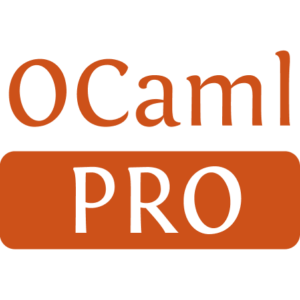Improving the OCaml documentation toolchainOn , by
Last week, we published an alpha version of a new OCaml documentation generator, codoc 0.2.0. In the 2014 OCaml workshop presentation (abstract, slides, video), we mentioned the 'module wall' for documentation and this attempts to fix it. To try it out, simply follow the directions in the README on that repository, or browse some samples of the current, default output of the tool. Please do bear in mind codoc and its constituent libraries are still under heavy development and are not feature complete.
codoc's aim is to provide a widely useful set of tools for generating OCaml
documentation. In particular, we are striving to:
- Cover all of OCaml's language features
- Provide accurate name resolution and linking
- Support cross-linking between different packages
- Expose interfaces to the components we've used to build
codoc - Provide a magic-free command-line interface to the tool itself
- Reduce external dependencies and default integration with other tools
We haven't yet achieved all of these at all levels of our tool stack but are
getting close. codoc 0.2.0 is usable today (if a little rough in some areas
like default CSS). This post outlines the architecture of the new system to
make it easier to understand the design decisions that went into it.
The five stages of documentation
There are five stages in generating documentation from OCaml source code. Here we describe how each was handled in the past (using OCamldoc), the present (using our current prototype), and the future (using the final version of the tools we are developing).
Associating comments with definitions
The first stage is to associate the various documentation comments in
an .ml or .mli file with the definitions that they correspond to.
Past
Associating comments with definitions is handled by the OCamldoc tool, which does this in two steps. First it parses the file using the regular OCaml parser or camlp4, just as in normal compilation. It uses the syntax tree from the first step and then re-parses the file looking for comments. This second parse is guided by the location information in the syntax tree; for example if there is a definition which ends on line 5 then OCamldoc will look for comments to attach to that definition starting at line 6.
The rules used for attaching comments are quite intricate and whitespace dependent. This makes it difficult to parse the file and attach comments using a single parser. In particular, it would be difficult to do so in a way that doesn't cause a lot of problems for camlp4 extensions. This is why OCamldoc does the process in two steps.
A disadvantage of this two-step approach is that it assumes that the input to any preprocessor is something which could reasonably be read by the compiler/tool creating documentation, which may not always be the case.
Present
Our current prototype associates comments with definitions within the
compiler itself. This relies on a patch to the OCaml compiler
(pull request #51 on GitHub).
Comment association is activated by the -doc command-line flag. It
uses (a rewritten version of) the same two-step algorithm currently
used by OCamldoc. The comments are then attached to the appropriate node
in the syntax tree as an attribute. These attributes are passed through
the type-checker and appear in .cmt/.cmti files, where they can be
read by other tools.
Future
We intend to move away from the two-step approach taken by OCamldoc. To do this we will need to simplify the rules for associating comments with definitions. One suggestion was to use the same rules as attributes, however that seems to be overly restrictive. So the approach we hope to take is to keep quite close to what OCamldoc currently supports, but disallow some of the more ambiguous cases. For example,
val x : int
(** Is this for x or y? *)
val y : floatmay well not be supported in our final version.
We will take care to understand the impact of such design decisions and we
hope to arrive at a robust solution for the future.
By avoiding the two-step
approach, it should be safe to always turn on comment association rather
than requiring a -doc command-line flag.
Parsing the contents of comments
Once you have associated documentation comments with definitions, you must parse the contents of these comments.
Past
OCamldoc parses the contents of comments.
Present
In our current prototype, the contents of comments are parsed in the
compiler, so that the documentation attributes available in
.cmt/.cmti files contain a structured representation of the
documentation.
Future
We intend to separate parsing the contents of documentation comments
from the compiler. This means that the documentation will be stored as
strings within the .cmt/.cmti files and parsed by external
tools. This will allow the documentation language (and its parser) to
evolve faster than the distribution cycle of the compiler.
Representing compilation units with types and documentation
The typed syntax tree stored in .cmt/.cmti files is not a convenient
representation for generating documentation from, so the next stage is
to convert the syntax tree and comments into some suitable intermediate
form. In particular, this allows .cmt files and .cmti files to be
treated uniformly.
Past
OCamldoc generates an intermediate form from a syntax tree, a typed syntax tree, and the comments that it found and parsed in the earlier stages. The need for both an untyped and typed syntax tree is a historical artefact that is no longer necessary.
Present
Our current prototype creates an intermediate form in the
doc-ock library. This form can be
currently be created from .cmti files or .cmi files. .cmi files do
not contain enough information for complete documentation, but you can
use them to produce partial documentation if the .cmti files are not
available to you.
This intermediate form can be serialised to XML using doc-ock-xml.
Future
In the final version, doc-ock will also support reading .cmt files.
Resolving references
Once you have a representation for documentation, you need to resolve all the paths and references so that links can point to the correct locations. For example,
(* This type is used by {!Foo} *) type t = Bar.t
The path Bar.t and the reference Foo must be resolved so that the
documentation can include links to the corresponding definitions.
If you are generating documentation for a large collection of packages, there
may be more than one module called Foo. So it is important to be able
to work out which one of these Foos the reference is referring to.
Unlike most languages, resolving paths can be very difficult in OCaml due to the powerful module system. For example, consider the following code:
module Dep1 : sig
module type S = sig
class c : object
method m : int
end
end
module X : sig
module Y : S
end
end
module Dep2 :
functor (Arg : sig module type S module X : sig module Y : S end end) ->
sig
module A : sig
module Y : Arg.S
end
module B = A.Y
end
type dep1 = Dep2(Dep1).B.c;;Here it looks like, Dep2(Dep1).B.c would be defined by a type
definition c within the submodule B of the functor Dep2. However,
Dep2.B's type is actually dependent on the type of Dep2's Arg
parameter, so the actual definition is the class definition within the
module type S of the Dep1 module.
Past
OCamldoc does resolution using a very simple string based lookup. This
is not designed to handle collections of projects, where module names
are not unique. It is also not sophisticated enough to handle advanced
uses of OCaml's module system (e.g. it fails to resolve the path
Dep2(Dep1).B.c in the above example).
Present
In our current prototype, path and reference resolution are performed by
the doc-ock library. The implementation
amounts to a reimplementation of OCaml's module system that tracks
additional information required to produce accurate paths and references
(it is also lazy to improve performance). The system uses the digests
provided by .cmti/.cmi files to resolve references to other modules,
rather than just relying on the module's name.
Future
There are still some paths handled incorrectly by doc-ock-lib, which will be fixed, but mostly the final version will be the same as the current prototype.
Producing output
Finally, you are ready to produce some output from the tools.
Past
OCamldoc supports a variety of output formats, including HTML and LaTeX. It also includes support for plugins called "custom generators" which allow users to add support for additional formats.
Present
codoc only supports HTML and XML output at present, although extra output
formats such as JSON should be very easy to add once the interfaces settle
down. codoc defines a documentation index XML format for tracking package
hierarchies, documentation issues, and hierarchically localized configuration.
codoc also defines a scriptable command-line interface giving users access
to its internal documentation phases: extraction, linking, and rendering. The
latest instructions on how to use the CLI can be found in the
README. We provide an OPAM remote with
all the working versions of the new libraries and compiler patches required to
drive the new documentation engine.
Future
As previously mentioned, codoc and its constituent libraries doc-ock-lib and doc-ock-xml are still under heavy development and are not yet feature complete. Notably, there are some important outstanding issues:
- Class and class type documentation has no generated HTML. (issue codoc#9)
- CSS is subpar. (issue codoc#27)
- codoc HTML does not understand
--package. (issue codoc#42) - opam doc is too invasive (temporary for demonstration purposes; tracked by (issue codoc#48))
- Documentation syntax errors are not reported in the correct phase or obviously enough. (issue codoc#58)
- Character sets are not handled correctly (issue doc-ock-lib#43)
- -pack and cmt extraction are not supported (issue doc-ock-lib#35 and issue doc-ock-lib#3)
- Inclusion/substitution is not supported (issue doc-ock-lib#2)
We are very happy to take bug reports and patches at https://github.com/dsheets/codoc/issues. For wider suggestions, comments, complaints and discussions, please join us on the Platform mailing list. We do hope that you'll let us know what you think and help us build a next generation documentation tool which will serve our community admirably.



